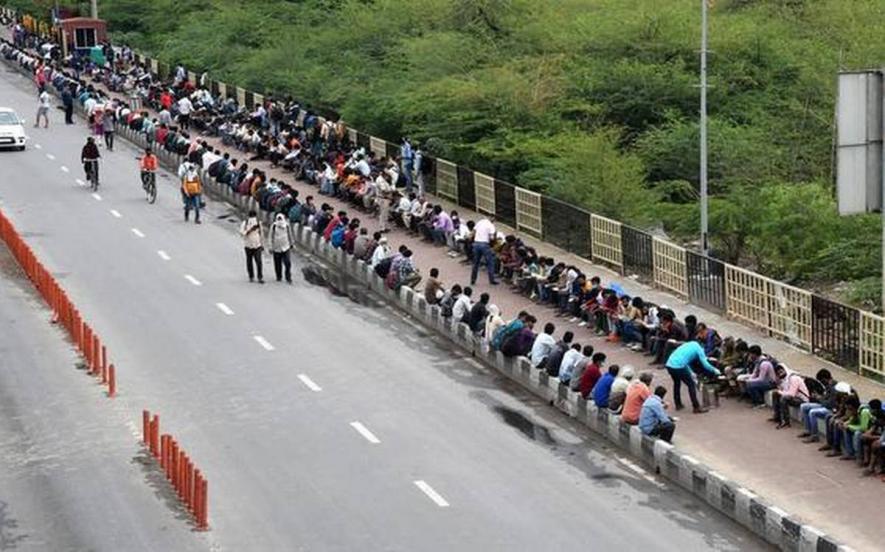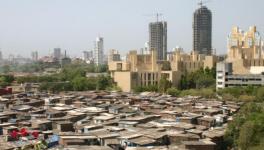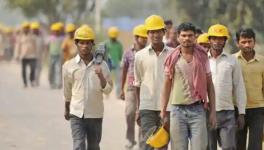How a Badly Planned Lockdown is Turning into Full Scale Disaster

Migrant workers, who are forced to walk to their hometowns as the 21 days long lockdown continues in India, rest at Ghazipur in Delhi-Uttar Pradesh border. | Image Courtesy: The Hindu
With an incredible inability to think things through, discuss matters with states and plan in advance, the Narendra Modi government has yet again turned the fight against the coronavirus into a mess of epic proportions. No country has rushed into a complete three-week-long lockdown to stop the disease, and definitely not in this cavalier manner. But, even if – for arguments’ sake – one believes that such a drastic lockdown was needed, who could have imagined that Prime Minister Modi would yet again make such a hash out of it?
If you recall the 2016 demonetisation disaster, one would be forced to accept – yes, that this government is capable of gross, criminal mismanagement. At its root, perhaps, lies a contempt for the common Indians, expendable as always for larger ‘causes’, invariably defined by Modi under advise from his favourite whiz-kids. But that’s for later: Let us look at the tragedy that is unfolding before our eyes, right now.
Tragedy of Migrant Workers
“My factory has stopped work. We used to stay there only. There is no option but to leave, but there is no money, no food, no transport… What can we do?” says a gaunt and worried Ram Asrey, as he waits at the Seemapuri border in East Delhi along with a group of his friends and relatives. He has a vague idea about walking down to his native village in Sultanpur in Eastern UP. They have been lucky because CITU (Centre of Indian Trade Unions) workers met them and provided them a kit of rice, dal, and some other essentials, all bought from a nearby provisions store.
Lakhs of migrant workers across the country are on the roads, hounded by police personnel and local residents, as they try to figure out their long journey home in Uttar Pradesh, Bihar, Madhya Pradesh, Jharkhand, Chhattisgarh -- states known for extreme poverty and hence big out-migration in search of livelihoods.
Was the Modi government unaware of this reality, of the existence of these uprooted labourers? That’s impossible. Every Census in India devotes a series of data tables on migrants. The latest 2011 Census revealed that 13.9 crore Indians migrated between 2001 and 2011, 10% of whom did so for “employment”. That’s about 1.4 crore migrants in that decade alone.
A vast majority of these migrants work without any legal protection, in the unorganised sector. That means there are no social security benefits, no savings, no safety net. There used to be a law for protection of inter-state migrant workers till it was merged in one of the labour Codes recently. Reams have been written about migrant workers by academics, activists and even in government reports.
Read Also: COVID-19 Lockdown: Unbearable Half Measures of Modi Government
Yet, when contemplating the lockdown, it seems the Modi government did not even consider this issue: a complete lockdown would mean these workers would have to go back to their villages. That such a movement would defeat the very purpose of social distancing and ban on travel, thus potentially leading to transmission of the virus far and wide, doesn’t seem to have troubled the minds of Modi and his whiz-kids at all.
So, what could the government have done?
For starters, it could have announced a future date for the lockdown. Modi gave four days to the people to prepare for the ‘Janata Curfew’ and only four hours to millions of people, especially poor migrant workers? After all, over two months have passed since it became increasingly clear that the pandemic was coming, and would need tough responses. It could have transferred a lumpsum to all the workers through the multpile databases they have in their possession. Just a tide-over amount, say, Rs.4,000 each.
The government could also have arranged safety and protection of workers and also set up transport mechanisms, like running special trains and buses. Or, better still, arranged for them to stay on under government care, if necessary, for which the states should have been kept in the loop. There were a hundred things that could have been done. The Kerala government has already taken many of these steps, so have some other states, such as Delhi, Odisha, Punjab, which have taken several initiatives.
But, for the Modi government, the workers – and the poor in general – are not on their radar.
Tinkering Around With the Economy
Perhaps, the Modi government has set its sights on setting the economy right during and after the lockdown. This would fit in with their stated philosophy that “wealth creators” need to be cared for, then everybody else is taken care of. So, what has the Modi government announced for the economy?
First, a so-called stimulus package of Rs.1.7 lakh crore for the welfare of the people has been announced. This would, it is thought, pump money into the economy, as people will spend thereby creating demand. However, most of this money was already in the system. Some Rs.31,000 crore was in the Building and Construction Workers’ Cess, another Rs.25,000 crore was in the District Mineral Fund, the PM-KISAN money was already voted for in the Budget, and so on. So, it is not a stimulus actually – that would mean an additional sum being injected under these dire circumstances, when the economy is projected to contract by as much as 4% of GDP.
Second, the Reserve Bank has also announced a slew of measures that include cutting interest rates on lending to and from banks (repo and reverse repo rates), reduction in the Cash Reserve Ratio (CRR) of banks, that helps them release more cash through loans, changes in the Statutory Reserve Ratio (SRR), deferring EMIs for three months etc., again to increase lending capacity and other such monetary policy measures.
What does all this mean in plain English? This means that more money is available for borrowing. Industrialists and other businesses can borrow more, thereby, it is hoped, invest more in expanding their productive capacity – and thus boost the economy.
This is cloud cuckoo land thinking, pure and simple. COVID-19 is delivering a body blow to both demand and supply, globally. Which business in their right minds would start new functions in these times? Where is the labour? Where is the demand? This move – usually undertaken in times of financial crises – has been copied without any thought. It shows the complete bankruptcy of those at the helm of the country. All this so-called package will do is increase bad loans, which will come to bite back, and public money will be squandered in write offs, while corporate honchos will laugh all the way to banks, probably in the Caribbean, or some other tax haven.
Clearly, the Modi government has virtually no control over events. It is dealing with the pandemic as if it’s a law and order problem, and it is dealing with the economy as if it’s a financial crisis of the usual sort. Meanwhile, healthcare personnel are tending to COVID patients in home-made masks, isolation beds are mainly on paper, and testing is being done for those with heft, or foreign travelers, or contacts thereof. India awaits the whirlwind.
Get the latest reports & analysis with people's perspective on Protests, movements & deep analytical videos, discussions of the current affairs in your Telegram app. Subscribe to NewsClick's Telegram channel & get Real-Time updates on stories, as they get published on our website.
























